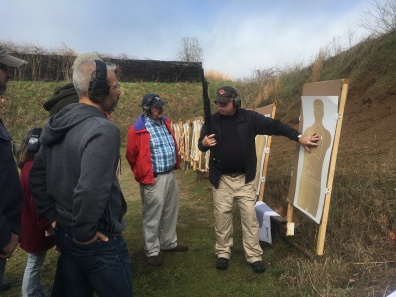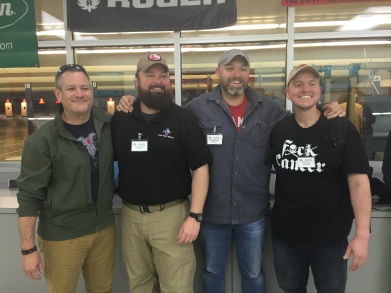This was an eight hour course on the history, and contextual implementation of short impact weapons. It was hosted at The Complete Combatant in Marietta, Ga. This course was magical in several ways and is a must take if you really dig leather and lead self-defense tools. I loved it because it deals with an arcane, but extremely effective, self defense implement. Larry Lindenman is a friend and mentor to me, and I’ve been reading and training with him since 2008 or so. It also was full of great trainers and practitioners, including Greg Ellifritz of Active Response Training, who I also consider a dear friend. It was a hell of a Saturday. Here’s a breakdown.
What is a Sap,Blackjack, or slungshot?
I’m not a historian on these tools, but I can give you a quick rundown on their construction. Here’s a recently published book on the history of these tools and their use if you’re interested in that. They were first documented in the 1700’s as a sailor’s tool made of pigskin and stuffed with sand used for some sort of impact duty on a ship. I guess they also realized you could get in a drunken brawl with them and they would work well as an impact weapon. They were flattened out and became saps in the 1940’s. They evolved,were perfected, and used to good effect up through the 1980’s when they fell out of favor.
Unlike a knife, which deals no ballistic impact, a sap can deal a real immediate physiological stop. They also don’t cause someone to bleed their loathsome blood-borne pathogens all over you when used in a fight (H/T The Tactical Professor for that point)

A sap is a flattened lead weight wrapped in leather, often with a strap for retention. The sap is easily carried next to the wallet in the back pocket, with enough material outside the pocket to acquire a grip and access. It has the advantage of two impact surfaces. You can choose to hit with the flat, or the edge, giving options in severity of damage depending on targeting. Saps are my preference.

A blackjack is a cylindrical impact tool, usually with a spring running through the grip, and a lead weight cast onto the head, all wrapped up in leather. They’re harder to carry daily, but their sprung weight makes them extremely potent when striking.

A slungshot is some sort of weight, with a rope-like handle. Think a handkerchief tied around the hasp of a padlock. You choke your grip right up next to the weight, and swing it like that. Otherwise it bounces all over the place and can smash your face after you strike.
The Contextualized Self-Defense Approach
I’m not ruining any of the magic of working with Larry (or any Shivworks instructor) because the magic isn’t in the information, but in doing the work. You’ll quickly notice themes in any Shivworks instructor’s material. This is by design, and for simplicity. A clear path, with simple rules and goals, yields a high retention and success rate. That’s the elegance of the model these guys use.
The instruction progresses in a logical manner, with each following phase resulting from some failure of the previous phase. The coursework progresses from the managing unknowns phase which includes verbalization, movement, and the use of the fence hand posture.

It then moves to a default cover position which is a non-diagnostic ‘helmet’ that helps you stay upright and conscious as a surprise attack is launched on you.

Then comes the grappling phase, where some simple modifications to proven sport grappling techniques address the possibility of your opponent having his own weapons. The goal is to get behind or tie up your opponent long enough to decide what to do next.
For this course, it was to access an impact tool and begin striking. It could also be accessing a pistol, a knife, or a throw to hit your opponent with the earth. The path is the same, no matter the tool you’re carrying. This is the power of this ‘system’ if you want to call it that.
After this worst-case scenario of having to access the tool in the fight, we worked on preemptive access, which is a whole lot easier.

Where and How to Strike?
While these are considered “less-lethal tools”, it’s really easy to deal a deadly blow with one, so some training is needed. The temple, base of skull, and possibility of a knock-out and secondary impact with the head bouncing off the pavement could certainly be deadly. We learned how to generate power through our hips and deliver blows in short arcs. The space needed to implement the tools is different than a blade or gun, so we worked those skills.
We concentrated on targeting large muscle groups, joints, clavicle, ribs, arms, thighs. We learned both broken strikes (think a piston pumping), and carry-through strikes (think slashes that set up strikes in the opposite direction).
Training Drones for practice
My New Foster Brother’s Sap
The Foster Brothers are the gold standard for leather saps and jacks today. I took a picture of one of Larry’s saps, and asked Todd to make one for me. It arrived yesterday and I’m very pleased. I don’t know what model sap it is, I’m glad I took a photo to send with my request. FOSTER IMPACT DEVICES
Tidbits
- Don’t waste your money on a ‘coin purse’ sap. Everyone (TSA, cops, etc) knows what it is, and coins aren’t really dense enough to add meaningful weight for your strikes.
- Why not brass-knuckles? Simply put, access. A blackjack can be accessed in-fight like a fixed blade knife and be put right into action. Knucks require you to put 4 fingers in 4 finger sized holes. Knucks are more of a pre-meditated and preemptive impact tool.
- It’s legal for GA residents to carry an impact weapon, you should check for your state before you buy/make your own.
- Quick and Dirty history of jacks and saps
- The LAMB method full text document HERE

Me, Larry Lindenman, Greg Ellifritz


























